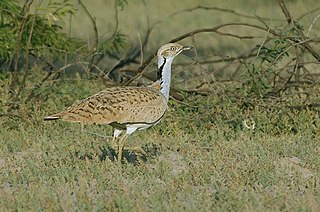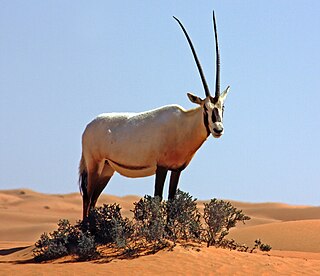Saja Umm Ar-Rimth Natural Reserve is a protected area in Saudi Arabia managed by the Saudi Wildlife Authority. [1]
The natural reserve is located in central Saudi Arabia with an area of 6,528.2 km2 (2,520.6 sq mi). It was designated as a natural reserve in 1995. [2]
The reserve is a destination for migrant Houbara. In 1998, the reserve is selected as a site for Houbara re-introduction. [3]

The Arabian Desert is a vast desert wilderness in Western Asia that occupies almost the entire Arabian Peninsula. It stretches from Yemen to the Persian Gulf and Oman to Jordan and Iraq. It occupies most of the Arabian Peninsula, with an area of 2,330,000 square kilometers (900,000 sq mi). It is the fifth largest desert in the world, and the largest in Asia. At its center is Ar-Rub' al-Khali, one of the largest continuous bodies of sand in the world. It is an extension of the Sahara Desert.

The sand cat is a small wild cat that inhabits sandy and stony deserts far from water sources. With its sandy to light grey fur, it is well camouflaged in a desert environment. Its head-and-body length ranges from 39–52 cm (15–20 in) with a 23–31 cm (9.1–12.2 in) long tail. Its 5–7 cm (2.0–2.8 in) short ears are set low on the sides of the head, aiding detection of prey moving underground. The long hair covering the soles of its paws insulates its pads against the extremely hot and cold temperatures in deserts.

The Mecca Province, also known as the Mecca Region, is one of the 13 provinces of Saudi Arabia. It is the third-largest province by area at 153,128 km2 (59,123 sq mi) and the most populous with a population of 8,557,766 as of 2017, of which 4,041,189 were foreign nationals and 4,516,577 were Saudis. It is located in the historic Hejaz region, and has an extended coastline on the Red Sea. Its capital is Mecca, the holiest city in Islam, and its largest city is Jeddah, which is Saudi Arabia's main port city. The province accounts for 26.29% of the population of Saudi Arabia and is named after the holy city of Mecca.

The Arabian leopard is a leopard subspecies native to the Arabian Peninsula. It has been listed as Critically Endangered on the IUCN Red List since 1996 as fewer than 200 wild individuals were estimated to be alive in 2006. The population is severely fragmented. Subpopulations are isolated and not larger than 50 mature individuals. The population is thought to decline continuously.

MacQueen's bustard is a large bird in the bustard family. It is native to the desert and steppe regions of Asia, west from the Sinai Peninsula extending across Kazakhstan east to Mongolia. In the 19th century, vagrants were found as far west of their range as Great Britain. Populations have decreased by 20 to 50% between 1984 and 2004 mainly due to hunting and changes in land-use. MacQueen's bustard is a partial latitudinal migrant while the houbara bustard is more sedentary. Both species are the only members of the genus Chlamydotis. MacQueen's bustard used to be regarded as a subspecies of the houbara bustard and known as the "Asian houbara".

The Arabian oryx, also called the white oryx, was extinct in the wild as of 1972, but was reintroduced to the wild starting in 1982. Initial reintroduction was primarily from two herds: the "World Herd" originally started at the Phoenix Zoo in 1963 from only nine oryx and the Saudi Arabian herd started in 1986 from private collections and some "World Herd" stock by the Saudi National Wildlife Research Center (NWRC). As of 2009 there have been reintroductions in Oman, Saudi Arabia, Israel, the United Arab Emirates, and Jordan, and as of 2013 the IUCN Red List classifies the species as vulnerable.

The North African ostrich, red-necked ostrich, or Barbary ostrich is the nominate subspecies of the common ostrich from West and North Africa. It is the largest subspecies, making it the largest living bird.

The wildlife of Saudi Arabia is substantial and varied. Saudi Arabia is a very large country forming the bulk of the Arabian Peninsula. It has several geographic regions, each with a diversity of plants and animals adapted to their own particular habitats. The country has several extensive mountain ranges, deserts, highlands, steppes, hills, wadis, volcanic areas, lakes and over 1300 islands. The Saudi Arabian coastline has a combined length of 2640 km and consists of the Gulf of Aqaba and the Red Sea to the west while a shorter eastern coastline can be found along the Persian Gulf.
'Uruq Bani Ma'arid is a protected area in southern Saudi Arabia, located on the western edge of the Rub' al Khali, the largest sandy desert in the world. The protected area is divided into three sections; a core nature reserve; a zone where controlled grazing is permitted; and a hunting zone.

The wildlife of the United Arab Emirates is the flora and fauna of the country on the eastern side of the Arabian Peninsula and the southern end of the Persian Gulf. The country offers a variety of habitats for wildlife including the coast, offshore islands, mangrove areas, mudflats, salt pans, sand and gravel plains, sand dunes, mountain slopes, wadis and rocky summits. Because the terrain is so varied, it supports a greater number of species of plants and animals than might have been expected in this relatively small country.

The wildlife of Oman is the flora and fauna of this country in the southeastern corner of the Arabian Peninsula, with coasts on the Gulf of Oman and the Arabian Sea. The climate is hot and dry, apart from the southeastern coast, and the country offers a variety of habitats for wildlife including mountains, valleys, deserts, coastal plains and sea coasts.
Umm al-Qamari Islands in Saudi Arabia is a national nature reserve managed by the Saudi Wildlife Authority.
Raydah Natural Reserve is a 9.33 km² protected area in Saudi Arabia managed by the Saudi Wildlife Authority. The reserve situated adjacent to 'Asir National Park. It was listed as a protected area in 1989.
Majami'al-Hadb Reserve is a protected area in Saudi Arabia managed by the Saudi Wildlife Authority.
Shada Mountain Reserve is a natural reserve in Saudi Arabia managed by the Saudi Wildlife Authority. The reserve is home to key plant and animal species including the endangered Arabian leopard.
Nafud al-ʽUrayq Natural Reserve is a protected area in Saudi Arabia managed by the Saudi Wildlife Authority.
At-Taysiyah Natural Reserve is a protected area in Saudi Arabia managed by the Saudi Wildlife Authority.
Al-Khunfah Natural Reserve is a protected area in Saudi Arabia managed by the Saudi Wildlife Authority.
Al-Tubayq Natural Reserve is a protected area in Saudi Arabia managed by the Saudi Wildlife Authority.
{{cite web}}: CS1 maint: url-status (link)